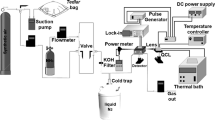Abstract
Alghough gaseous ammonia (NH3) can freely enter cells through the plasma membrane where NH3 is cyto(neuro)toxic, NH3 and ionic ammonia (NH4 +) contents have not been studied in biological materials. We developed a new method for measurement of expiratory NH3 concentration, which may reflect blood NH3 concentrations. The method is a sensor tube type-gas assay system. Expiratory NH3 concentrations in patients with chronic liver diseases increased when their blood ammonia (NH4 ++NH3) concentrations increased above 90 μg/dl (normal range; 12–66 μg/dl). However, cirrhotic patients, who had relatively higher expiratory NH3 concentration compared to blood NH3 concentrations (calculated from Henderson-Hasselbalch formula), were found to have subclinical encephalopathy. Measurement of experatory NH3 concentration may be of clinical significance for the diagnosis of encephalopathy associated with hyperammonemia.
Similar content being viewed by others
References
Cooper, A.J.L., and Plum, F. (1987). Biochemistry and physiology of brain ammonia.Physiol. Rev. 67: 440–519.
Glass, W.I. (1969). A case of ammonia gas exposure.Occup. Health 3:6–7.
Hayashi, S., Watanabe, A., Sogo, T., Higashi, T., Obata, T., and Nagashima, H. (1979). A simple-rapid method for determining blood ammonia levels of patients with liver diseases and its clinical evaluation.Jpn. J. Gastroenterol. 76:2194–2199.
Higuchi, K., Shimizu, Y., Nambu, S., Miyabayashi, C., Takahara, T., Saito, S.,et al. (1994). Effects of an infusion of branched chain amino acids on neurophysiological and psychometric testings in cirrhotic patients with mild hepatic encephalopathy.J. Gastroenterol. Hepatol. 9:366–372.
Jacobs, M.H. (1940). Some aspects of cell permeability to weak electrolytes.Cold Spring Harbor Symposium Quant. Biol. 8:30–39.
Jacquez, J.A., Poppell, J.W., and Jeltsch, R. (1959). Partial pressure of ammonia in alveolar air.Science 129:269–270.
Kar, S., and Arnold, M.A. (1992). Fiber-optic ammonia sensor for measuring synaptic glutamate and extracellular ammonia.Anal. Chem. 64:2438–2443.
Karube, M. (1985). Microbiological sensor.J. Clin. Technol. 29:1019–1022.
Kleiner, D. (1981). The transport of NH3 and NH4 + across biological membranes.Biochim. Biophys. Acta 639:41–52.
Pugh, R.N., Murray-Lyon, I.M., Dawson, J.L., Pietroni, M.C., and Williams, R. (1973). Transection of the esophagus for bleeding oesophageal varices.Brit. J. Surgery 60:646–649.
Raichle, M.E., and Larson, K.B. (1981). Significance of the NH3−NH4 + equilibrium on the passage of13N-ammonia from blood to brain. A new regional residue detection model.Circ. Res. 48:913–937.
Robin, E.D., Travis, D.M., Bromberg, P.A., Forkner, C.E.Jr., and Tyler, J.M. (1958). Ammonia excretion by mammalian lung.Science 129:270–271.
Saeki, T. (1994). Biochemistry of ammonia. In:Medical Ammoniology (A. Watanabe and T. Saeki), Medical Review Co. Ltd., Tokyo, p. 26–38.
Watanabe, A., Fujiwara, M., Tominaga, S., and Nagashima, H. (1987). Elevation of ammonia contents in the cerebral hemisphere under the blood-brain barrier opening.Hiroshima J. Med. Sci. 36:415–416.
Author information
Authors and Affiliations
Rights and permissions
About this article
Cite this article
Wakabayashi, H., Kuwabara, Y., Murata, H. et al. Measurement of the expiratory ammonia concentration and its clinical significance. Metab Brain Dis 12, 161–169 (1997). https://doi.org/10.1007/BF02674737
Received:
Accepted:
Issue Date:
DOI: https://doi.org/10.1007/BF02674737




